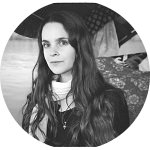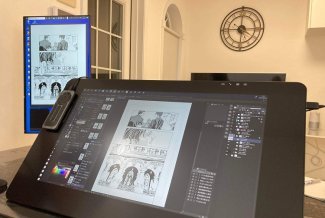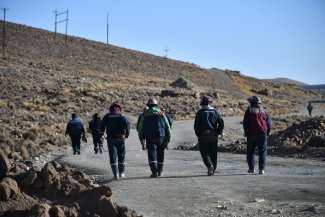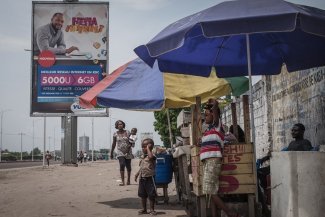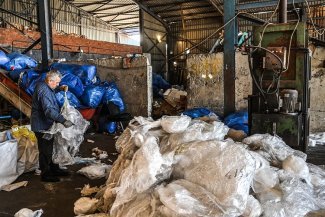A couple dressed in traditional Kurdish clothes celebrates Newroz eve in the mountains overlooking Sulaymaniya, Iraq.
On 20 March 2019, families and groups of friends gathered at sunset in the mountains surrounding Sulaymaniya in Iraqi Kurdistan. Wearing traditional Kurdish clothes, many sat on picnic blankets, some danced to the sound of popular music, while others gathered to talk around bonfires.
With the Kurdish New Year of 2719 fast-approaching, the sound of fireworks grew louder in the mountains overlooking Iraqi Kurdistan’s second largest city.
The first day of spring marks the New Year, known as ‘Newroz’ in Kurdish, which means ‘new day’ (it is also known as ‘Nowruz’ in Persian). Observed in many countries in the Middle East and central Asia, Newroz holds special importance to Kurdish people and is their most significant annual festival.
“Newroz is a celebration of spring and the New Year,” says Rozhim Ahmed, who drove to the mountains with her friends to mark the event. “But it is also a celebration of the struggles of Kurds and a celebration of victory over oppression.”
The Kurdish New Year begins when winter turns into spring on the March equinox. Across Kurdish regions, the festival commemorates the myth of Kawa, a blacksmith who rebelled against the evil King Zuhak and freed his people from oppression.
According to the legend, spring no longer came because of Zuhak’s reign of injustice. The blacksmith Kawa led an uprising against the tyrannical king, defeating him on the eve of Newroz. On the next day spring returned to Kurdistan.
To celebrate his victory, Kawa lit a fire on a mountaintop. The fire announced the end of oppression in the kingdom. And now, every year, 20 March is celebrated as the day Kawa defeated Zuhak. The following day is marked as New Year’s Day and the first day of spring.
Lighting bonfires and torches on Newroz is a common Kurdish tradition, and a symbol of freedom. The legend of Kawa was revived by militant groups in recent years as a symbol of Kurdish resistance.
“Newroz is proof that we exist”
Kurds are the world’s largest ethnic group without a state. They were excluded from the treaties imposed by colonial powers which defined the Middle East’s modern borders after the First World War.
Today, an estimated 30 million Kurds live as minorities dispersed between Turkey, Iraq, Syria and Iran. In all four nation-states their language and culture have been repressed, while their movements for self-determination or autonomy have been crushed.
In Syria, thousands of Kurds were stripped of citizenship and deprived of civil rights. In 2004, the discrimination and repression of Kurdish political and cultural rights led to the first uprising against Bashar al-Assad’s government. The protests against marginalisation were violently repressed by the Syrian government.
In Turkey, there is a long history of discrimination and repression of the Kurdish population. In response to uprisings in the 1920s and 1930s and with the rise of Turkish nationalism, Kurdish names were banned and the Kurdish language was restricted. Kurds were designated by the Turkish government as “mountain Turks” in an attempt to deny their existence.
“Newroz is proof that we exist,” Ardalan Salih tells Equal Times. “The festival is about Kurdish resistance and it reminds Kurds of our historical struggles.”
Salih works as a guide at Amna Suraka, also known as the “Red Prison”, a museum in Suleymaniya which commemorates the crimes committed against Kurdish people in Iraq. The persecution of Kurds under Saddam Hussein’s regime is perhaps the most well-known chapter of Kurdish people’s history of oppression. The museum is housed in the former headquarters of the northern division of the Ba’athist regime’s intelligence agency, where thousands of Kurdish nationalists and dissidents were tortured and killed.
To punish Kurds for siding with Iran in the Iran-Iraq war of 1980, Saddam Hussein unleashed a genocidal campaign against the Kurdish population. Between 1986 and 1989, the Iraqi government conducted the Anfal campaign, bombing and destroying Kurdish villages and utilising mass deportations, torture and chemical warfare against the Kurdish population. On 16 March 1988, a chemical gas attack on the Kurdish town of Halabja killed around 5,000 people.
According to Human Rights Watch, Anfal resulted in the “systematic and deliberate murder” of as many as 100,000 Kurds. One of the museum’s rooms commemorates the genocidal campaign with more than 100,000 jagged mirror pieces cemented to the walls and small light-bulbs on the ceiling. Each small piece of mirror represents a life lost, and the lights stand for the thousands of villages destroyed by the Hussein regime, explains Salih.
“March is a very important month for the Kurdish people,” he says. “It’s the month of Halabja and many of Anfal’s chemical attacks, but it is also the month of Newroz, our most important festival.”
“It’s so important to remember our past”
After Iraq’s defeat in the Gulf war, Kurds rebelled against Hussein’s government in March 1991. The regime responded by sending tanks and artillery to Kurdish villages. Already too familiar with the Ba’ath government’s brutality, more than one million Kurds fled to the mountains for safety.
The violent suppression of the Kurdish uprising of 1991 prompted the US and its allies to impose a no-fly zone which allowed Kurds to return to their homes. Fighting continued until an agreement was made for Iraq’s withdrawal, which led to the establishment of an autonomous region and the creation of the Kurdistan Regional Government (KRG) in 1992.
Rayan Hersh, a teenage girl visiting the Amna Suraka museum, looks closely at pictures of the tragedies suffered by Iraq’s Kurds: the Anfal campaign, Halabja, the 1991 exodus – all of which happened around the month of March.
“This year we decided to celebrate Newroz by coming to the museum,” says Hersh, who comes from a village outside Suleymaniya. “It’s so important to remember our past,” says the teenager. Her father stands silently next to her, nodding occasionally. Pointing to the gruesome photos of the Anfal massacres, he adds: “We hope that people who come to the museum will be convinced that this can never happen again.”
But Amna Suraka’s exhibition rooms have been expanding since the prison was overtook by Kurdish rebels in the 1990s and turned into a museum. Despite the oft-repeated assertion of “never again”, genocide continues to happen time and again. Most recently in Iraq, the so-called Islamic State’s genocidal campaign targeted the Yazidi minority for mass murder and rape.
A new section in the museum was inaugurated in 2017 to commemorate the recent crimes committed by Da’esh, as the so-called Islamic State is known in Arabic and Kurdish. More than 1,000 photos of those killed in Syria and Iraq at the hands of the extremist group fill the walls of the museum. Sobering portraits of men and women remind visitors of the tragic costs of war. Most of them were young members of the Kurdish forces, the most effective groups fighting against Da’esh on the ground.
On 23 March 2019, just two days after Newroz, the Kurdish-led Syrian Democratic forces (SDF) announced Da’esh’s defeat. But Ali Saleh, a commander in the Kurdish military forces known as the Pershmerga, says it is too early to celebrate, since extremist groups remain a threat in the region.
“Daesh will not be defeated just with weapons. We need to fight the terrorist ideology as well,” he says. Saleh fought against Da’esh in August 2014, when the group approached the south of Erbil, the capital of the KRG. Daesh’s defeat coincided with Newroz.
“Kurds used to be a destitute and defenceless people. We used to say that we have no friends but the mountains,” says the museum guide Ardalan Salih. “But now we have more support from other countries. Now we have a regional government and autonomy, which makes us stronger and more hopeful about the future.”
Shleir Latif sells narcissus in Suleymaniya’s main market. The flower, which blooms in the beginning of spring, is a symbol of the Kurdish New Year. “Newroz is a celebration of new beginnings,” says Latif in the busy market where she has worked for over 30 years. “It’s a celebration of hope,” she adds. And a reminder that even the darkest days of winter are always followed by spring.



